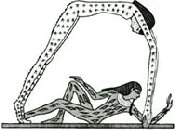
Geb
(Seb, Keb)
(Seb, Gebb, Keb, Kebb)
Symbols: goose, earth
Cult Center: Heliopolis
Geb was the son of Shu and Tefnut and the brother and husband of Nut. Through Nut he had four children, Osiris, Isis, Seth and Nephthys.
Geb was the god of the earth. Even so, Geb guided the dead to heaven and he gave them meat and drink. It is interesting to note that while in most cultures the deity associated with the earth and it's bounty is a woman ("Mother Earth", Demeter of the Greeks, etc...), the Egyptians chose a male for this role.
A Late Period stele, the Phakussa stele, tells how Geb fell in love with his mother, Tefnut. He pined for her and traveled throughout Egypt until his father Shu, who was the king of Egypt, died. On that day, Geb went to his father's palace in Memphis and found Tefnut. He took his mother and violently raped her. It seems that he was not punished for this. He went on to become a mighty king and earned the exclusive title, "Heir of the Gods." Geb was so admired as a ruler, that the Egyptian throne was known by the epithet, "Seat of Geb."
He is usually shown as a man wearing either the crown of the North or of the South. Added is either the Atef crown or a goose. The goose was a sacred animal to Geb, as such he was sometimes called "The Great Cackler" It was said that Geb's laughter was the source of earthquakes.

Other images show him lying underneath his wife (Nut, goddess of the sky) and his father (Shu, god of the air). He reclines on one elbow with a knee and arm in the air. In this way he symbolized the valleys and hills of the land, which was called "The House of Geb." He is shown either as a dark or green skinned man (the colors of life, the soil of the Nile and vegetation, respectively) with leaves on his skin.
The religious center of Geb seems to be Heliopolis (near Cairo), where he and Nut produced the Great Egg from which the Sun-god sprang.
Digg This!
![]() Del.icio.us
Del.icio.us
![]() Stumble Upon
Stumble Upon
